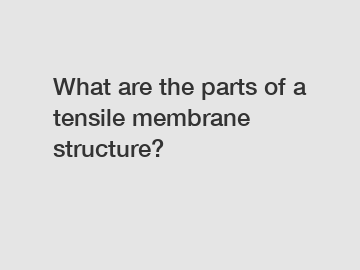What are the parts of a tensile membrane structure?
What are the parts of a tensile membrane structure?
A tensile membrane structure consists of several key components that work together to create a lightweight, flexible, and unique architectural form. These components include the membrane, cables, connectors, and boundary elements. .
The membrane is the primary element of a tensile structure and is what provides the shape and enclosure. It is typically made of a flexible material such as PVC, PTFE-coated fiberglass, or ETFE foil. The membrane is tensioned and anchored to form the desired structure. .

Cables play an important role in distributing and transferring the tensile forces within the structure. They are usually made of stainless steel or high-strength fibers such as aramid. Cables are essential for providing stability and supporting the membrane, especially in larger spans.
Connectors are the elements that join the cables and membrane together. They can be in the form of bolts, clamps, or plates. Connectors are responsible for distributing the tension and compression forces evenly across the structure, ensuring its stability and integrity.
Boundary elements are elements that define the overall shape and provide support to the structure. These elements include columns, beams, or masts. Boundary elements play a crucial role in anchoring the structure and providing additional support to counteract external forces such as wind or snow loads.
The concept of tensile membrane structures originates from the ancient practice of tent-making. The use of fabric or membrane as a structural element dates back thousands of years. The nomadic tribes of Central Asia relied on tensile structures, such as yurts, for their portability and durability. In modern times, advancements in materials and engineering have allowed for the development of more sophisticated tensile membrane structures.
The primary significance of tensile membrane structures lies in their lightweight and flexible nature. Compared to traditional building materials such as concrete or steel, tensile structures are much lighter, which leads to significant cost savings in terms of transport and construction. Additionally, the flexibility of the membrane allows for endless possibilities in architectural design. Tensile structures can be shaped into curves, domes, or complex geometric forms, creating visually stunning and aesthetically pleasing spaces.
Another important aspect of tensile membrane structures is their sustainable and environmentally friendly nature. The lightweight materials used in their construction require less energy to produce and transport compared to traditional building materials. The tensile structures' ability to allow natural light transmission reduces the need for artificial lighting during the day, resulting in energy savings. Furthermore, the tensioned membrane can act as a natural shading device, reducing the cooling load on the building.
In conclusion, the parts of a tensile membrane structure include the membrane, cables, connectors, and boundary elements. This architectural form draws upon ancient tent-making practices and provides numerous benefits such as cost savings, flexibility in design, and sustainability. Tensile membrane structures have revolutionized the architectural industry and continue to inspire innovative designs worldwide.
If you want to learn more, please visit our website space frame structures, Space Frame Chassis For Sale, Space Frame Structures For Railway Stations.
216
0
0

Comments
All Comments (0)